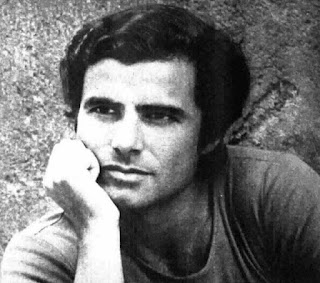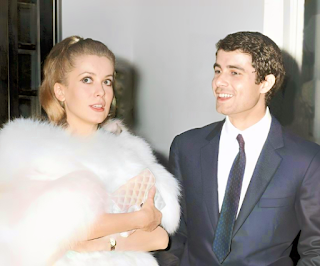NEW - Nino Castelnuovo - actor
Starred in sumptuous French musical and TV adaptation of literary classic
The actor Nino Castelnuovo, best known for playing opposite a young Catherine Deneuve in a Palme d’Or-winning French musical and as the star of a celebrated TV adaptation of Alessandro Manzoni’s classic novel I promessi sposi (The Betrothed), died on this day in 2021 at the age of 84. Castelnuovo’s talent came to the fore during a golden age of Italian cinema, working with leading directors such as Luchino Visconti, Vittorio De Sica, Pietro Germi, Luigi Comencini and Pier Paolo Pasolini, and starring opposite such luminaries as Alberto Sordi, Monica Vitti and Claudia Cardinale. Yet it was the visually beautiful, deeply sentimental French musical, Le parapluies de Cherbourg - The Umbrellas of Cherbourg - that catapulted him to fame in 1964, five years after his screen debut. Directed by Jacques Demy, the musical, in which the dialogue is entirely sung (although by voice dubbers rather than the actors appearing on screen), Castelnuovo played the handsome Guy, a mechanic, who is in love with Deneuve’s character, Geneviève, who works in her mother’s umbrella shop. Read more…
_____________________________________
Andrea Camilleri – author
Creator of Inspector Montalbano
Writer and film producer Andrea Camilleri, who died in 2019, was born on this day in 1925 in Porto Empedocle in Sicily. Famous for creating the fictional character Inspector Montalbano, Camilleri is a prolific, best-selling novelist who has generated worldwide interest in the culture and landscapes of Sicily. Camilleri studied literature and although he never completed his course he began to write poems and short stories. He was taught stage and film direction and became a director and a screenwriter. He worked on several television productions for RAI, including the Inspector Maigret series. He wrote his first novel in 1978 but it was not until 1992 that one of his novels, La stagione della caccia - The Hunting Season - became a bestseller. In 1994 Camilleri published La forma dell’acqua - The Shape of Water - which was the first novel to feature the character of Inspector Montalbano, a detective serving the police in Vigàta, an imaginary Sicilian town. The book was written in Italian but had a real Sicilian flavour, with local phrases and sayings and descriptions of the classic Sicilian dishes particularly favoured by Montalbano. Read more…
______________________________________
Giovanni Fattori - painter
Landscape artist who painted Risorgimento battle scenes
The painter Giovanni Fattori, who campaigned to free Italy from Austrian domination and captured Risorgimento battle scenes on canvas, was born on this day in 1825 in Livorno. Fattori became a leading member of a group of Tuscan painters known as the Macchiaioli, who have been described as the Italian equivalent of the French Impressionists but whose images were more sharply defined. The group, largely comprising painters from a working class background, saw themselves more as a social movement who expressed themselves through art. Born into a modest household in the Via della Coroncina in the centre of Livorno, the Tuscan port city, Fattori’s family hoped he would seek a qualification in commerce that would equip him to prosper in the city’s trade-based economy. But his skill in sketching persuaded them instead to apprentice him in 1845 to Giuseppe Baldini, a local painter of religious themes. The following year he moved to Florence to study under Giuseppe Bezzuoli and enrol at the Academy of Fine Arts in Florence. It was while he was in Florence, in 1848, that he became politically active, joining the Partito d’Azione. Read more…
_____________________________________
Francesco I d’Este – Duke of Modena
Military leader left legacy of fine architecture
Francesco I, Duke of Modena, who was to be immortalised in a bust by the sculptor, Gian Lorenzo Bernini, was born on this day in 1610 in Modena in Emilia-Romagna. He is remembered as a skilful military commander, who enriched Modena with the building of the Ducal Palace. Francesco was the eldest son of Alfonso III d’Este and Isabella of Savoy and became Duke of Modena in 1629 after the death of his mother had prompted his grieving father to abdicate in order to take religious vows and become a Capuchin Friar in Merano. During the next two years about 70 per cent of the inhabitants of Modena were killed by the plague. The Duke’s father, now known as Fra’ Giambattista da Modena, tried to help the dying and went about preaching during the outbreak of plague, before retiring to a convent built by Francesco for him in Castelnuovo in Garfagnana. After the outbreak of the Thirty Years War, Francesco sided with Spain and invaded the Duchy of Parma, but when he went to Spain to claim his reward he was able to acquire only Correggio, for a payment of 230,000 florins. Francesco then sided with Venice, Florence and Parma against Pope Urban VIII and tried unsuccessfully to conquer Ferrara. Read more…
_____________________________________
Isabella Leonarda – composer
Devout nun wrote an abundance of Baroque music
Isabella Leonarda, a nun who was one of the most productive women composers of her time, was born on this day in 1620 in Novara. Leonarda’s published work spans a period of 60 years and she has been credited with more than 200 compositions. She did not start composing regularly until she was in her fifties, but noted in the dedication to one of her works that she wrote music only during time allocated for rest, so as not to neglect her administrative duties within the convent. Leonarda was the daughter of Count Gianantonio Leonardi and his wife Apollonia. The Leonardi were important people in Novara, many of them church and civic officials. Leonarda entered the Collegio di Sant’Orsola, a convent in Novara, when she was 16 and rose to a high position within the convent. Her published compositions began to appear in 1640 but it was the work she produced later in her life that she is remembered for today and she became one of the most prolific convent composers of the Baroque era. It is believed she taught the other nuns to perform music, which would have given her the opportunity to have her own compositions performed. Read more…
____________________________________
Book of the Day: The Betrothed (I promessi sposi), by Alessandro Manzoni
Set in Lombardy during the Spanish occupation of the late 1620s, The Betrothed tells the story of two young lovers, Renzo and Lucia, prevented from marrying by the petty tyrant Don Rodrigo, who desires Lucia for himself. Forced to flee, they are then cruelly separated, and must face many dangers including plague, famine and imprisonment, and confront a variety of strange characters - the mysterious Nun of Monza, the fiery Father Cristoforo and the sinister 'Unnamed' - in their struggle to be reunited. A vigorous portrayal of enduring passion, The Betrothed's exploration of love, power and faith presents a whirling panorama of 17th century Italian life and is one of the greatest European historical novels. (Introduced and translated by Bruce Penman).Alessandro Manzoni was born in 1785 near Lake Como, Italy. Sent to boarding school at the age of five, he felt estranged from his family, particularly when his mother left his father. As a young man Manzoni subscribed to the ideas of the French Revolution, joining his mother in Paris, where he married Henriette Blondel in 1808. He died in 1873.
.jpg)



.jpg)











.jpg)
.jpg)
.png)

.jpg)
